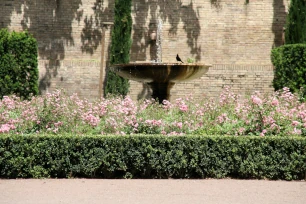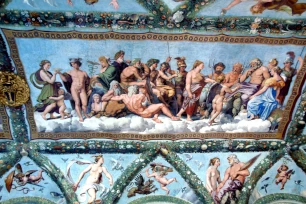Villa Farnesina is a Renaissance-era villa situated near the bank of the Tiber river. The house is known for its magnificent frescoed interior, created by master painters such as Raphael.
History
Villa Farnesina was built for Agostino Chigi, a fabulously wealthy banker with connections in high places. Popes turned to him when they needed to borrow large sums of money. In 1505 Chigi, who hailed from Siena, asked his fellow townsman Baldassare Peruzzi to build a residence for him in Trastevere, just outside the city walls.

The villa, which was completed five years later, was the site of lavish parties which were even attended by the pope. After Chigi’s death in 1520 the house, which at the time was known as Villa Chigi, stood empty for years and by the time it was acquired by cardinal Alessandro Farnese in 1580 the building had fallen into decay. Farnese, whose main residence was just across the river at Piazza Farnese, had the villa restored. It was during this time that the building acquired its current name.
In the eighteenth century the villa was passed on to the Bourbons of Naples and from 1861 on it was owned by the Spanish ambassador. In 1927 the villa became state property.
The Villa
Chigi wanted his villa to be similar to those from the antiquity and the architect, Perruzi, decided to blend the interior with the exterior. The result was a U-shaped building with two stories and two loggias that opened towards the garden and the river.
Exterior

The exterior was decorated with paintings of plants and atlantes – figures that seemed to support the building. Unfortunately, none of these decorations have survived, and neither has the riverside loggia. The other, formerly open loggia is now the main entrance. The original entrance is at the back.
The only exterior decorations still visible are the pilasters on the upper floor and terracotta decorations just below the cornice. The garden, which features a parterre with a central fountain, is also merely a shadow of its former self.
Interior
It is the interior however that is the main attraction of the Villa Farnesina. Chigi was one of very few people who could compete with the popes for the services of the greatest Renaissance artists, and the villa’s interior is a magnificent display of vibrant frescoes.

Chigi admired and tried to copy the lifestyle of the ancient Romans. He had a great interest in pagan mythology – quite unusual for someone with such high clerical connections – and as a result several frescoes depict mythological events.
The most famous of these frescoes are in the Galleria di Psyche, the loggia that looks out onto the formal gardens. The frescoes depict the story of Psyche and Cupid (the latter is also known as Eros or Amor) as told by Apuleius. The painting was completed in 1517 by assistants of Raphael, but the design was from the master himself, who was too occupied with his work in the Vatican Palace, so he could only paint a small section himself.
There are two large frescoes: one depicts the ‘Meeting of the Gods’ and the other the ‘Wedding between Psyche and Cupid’. The frescoes are divided into sections that are separated by garlands of flowers and fruit. One of the sections of the wedding fresco shows Cupid with the Three Graces. It is said that Imperia, the mistress of Agostino Chigi, was the model for the grace with her back towards the viewer.

Raphael, who was a friend of Chigi and who designed his private chapel in the Santa Maria del Popolo, was also responsible for the main fresco in the Sala di Galatea, which depicts the ‘Triumph of Galatea’. The figure of Galatea, one of the fifty daughters of Nereus, was painted by Raphael himself. The sea nymph is surrounded by mythological figures and rides a shell chariot pulled by two dolphins. Other frescoes in the room were created by Peruzzi, the architect of the villa, and depict mythical scenes featuring Perseus and Medusa. The ceiling fresco is also by Peruzzi and shows the constellation on Chigi’s birthday depicted with mythological and astrological images.
The most interesting room on the upper floor is the Sala delle Prospettive (Hall of perspectives), which has a trompe l’oeil painted by Peruzzi that gives the illusion that you’re looking through a marble colonnade over sixteenth-century Rome. Adjacent is the bedroom of Agostino Chigi, which features a beautiful wooden paneled ceiling. The walls are painted with scenes from the life of Alexander the Great. The highlight here is ‘The marriage between Roxana and Alexander’ a masterpiece of Giovanni Antonio Bazzi, who is better known by his nickname Il Sodoma. The fresco was completed in 1518.

